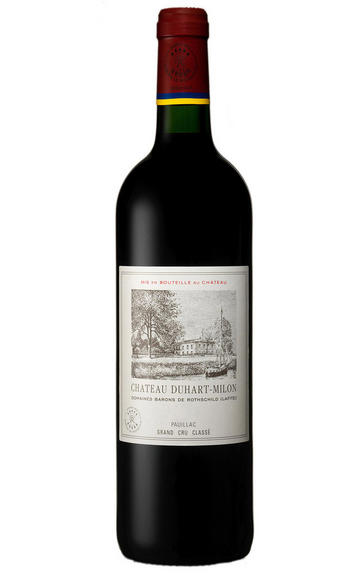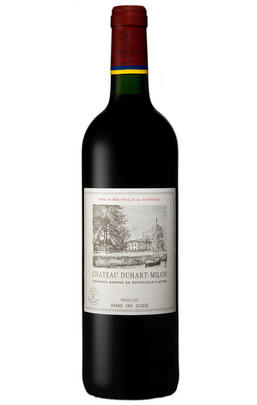
2021 Château Duhart-Milon, Pauillac, Bordeaux

Critics reviews
The 2021 Duhart-Milon, which is aged in 50% new oak, has a clean, precise bouquet of mineral-driven black fruit and touches of pencil lead and cedar. The palate is medium-bodied, fresh and focused, with sappy black fruit and fine depth. This is a typically classically styled Duhart-Milon, though it does not quite have the persistence to rank as a top-rank vintage. But it will appeal to those who appreciate old-school Pauillac.
Drink 2026 - 2045
Neal Martin, Vinous.com (May 2022)
Precise and finessed black fruits here right from the first moments, this is high Cabernet Sauvignon, lovely black savoury fruits that suit the slighly serious feel of Duhart. Expect precision, strict tannins, straight lines, plenty of freshness but without the rusticity that you could find in older Duharts. About 15% press wine after careful extraction and a short maceration. A little more old school Duhart than we have seen over the past few years, but thoroughly enjoyable. 1st year organic conversion, 30hl/h yields.
Drink 2025 - 2040
Jane Anson, JaneAnson.com (May 2022)
Incorporating fully 81% Cabernet Sauvignon, the 2021 Duhart-Milon unwinds in the glass with aromas of sweet berries, cigar wrapper and pencil shavings. Medium to full-bodied, lively and persuasively concentrated, with beautifully refined tannins and a long, penetrating finish, it's a classy, serious wine that reflects all the progress this estate has been making over the last decade.
William Kelley, Wine Advocate (April 2022)
Last time there was this much Cabernet was 2000 (but that was another vintage altogether…). Crimson hue but lighter at the rim. Pencil shavings and cassis notes. Upright and linear with a certain amount of drive but a little light in heft and structure. Could improve if it fills out in the bottle.
Drink 2026 - 2036
James Lawther, JancisRobinson.com (May 2022)
This is a really pretty Duhart and fans out nicely on the palate with medium soft tannins that are polished. Gorgeous young wine. 81% Cabernet Sauvignon and 19% Merlot.
James Suckling, JamesSuckling.com (June 2022)
A solid step up, the 2021 Château Duhart-Milon has terrific cassis, graphite, and tobacco notes in a medium-bodied, elegant style. I like its tannins, and it has good mid-palate depth as well as the fresher, almost crunchy style of the vintage.
Jeb Dunnuck, JebDunnuck.com (June 2022)
About this WINE

Chateau Duhart-Milon
Château Duhart Milon is a Pauillac estate owned by Domaines Barons de Rothschild that produces on average 28,000 cases of wine per year. The wine chais are located in Pauillac town and the property has a similar climate to that enjoyed by the Médoc: maritime, with the Gironde estuary and the Bay of Biscay combining to act as a climate regulator and the coastal pine forests sheltering the vines from the westerly and north-westerly winds.
Duhart Milon Rothschild's vineyards (Cabernet Sauvignon 65%, Merlot 30%and Cabernet Franc 5%) border Lafite Rothschild. Vinification includes oak ageing, up to 40% new.
Duhart Milon Rothschild is classified as a 4ème Cru Classé.

Pauillac
Pauillac is the aristocrat of the Médoc boasting boasting 75 percent of the region’s First Growths and with Grand Cru Classés representing 84 percent of Pauillac's production.
For a small town, surrounded by so many familiar and regal names, Pauillac imparts a slightly seedy impression. There are no grand hotels or restaurants – with the honourable exception of the establishments owned by Jean-Michel Cazes – rather a small port and yacht harbour, and a dominant petrochemical plant.
Yet outside the town, , there is arguably the greatest concentration of fabulous vineyards throughout all Bordeaux, including three of the five First Growths. Bordering St Estèphe to the north and St Julien to the south, Pauillac has fine, deep gravel soils with important iron and marl deposits, and a subtle, softly-rolling landscape, cut by a series of small streams running into the Gironde. The vineyards are located on two gravel-rich plateaux, one to the northwest of the town of Pauillac and the other to the south, with the vines reaching a greater depth than anywhere else in the Médoc.
Pauillac's first growths each have their own unique characteristics; Lafite Rothschild, tucked in the northern part of Pauillac on the St Estèphe border, produces Pauillac's most aromatically complex and subtly-flavoured wine. Mouton Rothschild's vineyards lie on a well-drained gravel ridge and - with its high percentage of Cabernet Sauvignon - can produce (in its best years) Pauillac's most decadently rich, fleshy and exotic wine.
Latour, arguably Bordeaux's most consistent First Growth, is located in southern Pauillac next to St Julien. Its soil is gravel-rich with superb drainage, and Latour's vines penetrate as far as five metres into the soil. It produces perhaps the most long-lived wines of the Médoc.
Recommended Châteaux
Ch. Lafite-Rothschild, Ch. Latour, Ch. Mouton-Rothschild, Ch. Pichon-Longueville Baron, Ch. Pichon Longueville Comtesse de Lalande, Ch. Lynch-Bages, Ch. Grand-Puy-Lacoste, Ch, Pontet-Canet, Les Forts de Latour, Ch. Haut-Batailley, Ch. Batailley, Ch. Haut-Bages Libéral.

Cabernet Sauvignon Blend
Cabernet Sauvignon lends itself particularly well in blends with Merlot. This is actually the archetypal Bordeaux blend, though in different proportions in the sub-regions and sometimes topped up with Cabernet Franc, Malbec, and Petit Verdot.
In the Médoc and Graves the percentage of Cabernet Sauvignon in the blend can range from 95% (Mouton-Rothschild) to as low as 40%. It is particularly suited to the dry, warm, free- draining, gravel-rich soils and is responsible for the redolent cassis characteristics as well as the depth of colour, tannic structure and pronounced acidity of Médoc wines. However 100% Cabernet Sauvignon wines can be slightly hollow-tasting in the middle palate and Merlot with its generous, fleshy fruit flavours acts as a perfect foil by filling in this cavity.
In St-Emilion and Pomerol, the blends are Merlot dominated as Cabernet Sauvignon can struggle to ripen there - when it is included, it adds structure and body to the wine. Sassicaia is the most famous Bordeaux blend in Italy and has spawned many imitations, whereby the blend is now firmly established in the New World and particularly in California and Australia.


Buying options
Add to wishlist
Description
Cabernet Sauvignon 81%, Merlot 19%
This 76-hectare Fourth Growth lies adjacent to its sibling Château Lafite Rothschild, on slightly cooler, finer gravel soils. There are concentrated, lightly spiced dark fruits on the nose – blackcurrants, blackberries, even a little blackberry coulis, and a touch of liquorice freshness. This feels serious yet complete, with refined intensity, silky tannins and a graphite mineral note to the core. Organic conversion is underway here.
Drink 2026 - 2040
Our score: 17.5/20
Berry Bros. & Rudd
wine at a glance
Delivery and quality guarantee